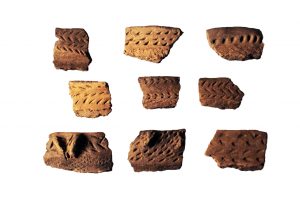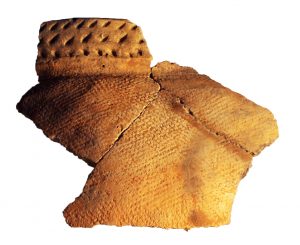Ward (Watauga County)
The Ward site (31WT22) is a late prehistoric palisaded village located on the west bank of Watauga River just upstream of its confluence with Cove Creek in Watauga County. Although the site was occupied many times, the village probably dates to between A.D. 1000 and 1300. A cabin was built on the site, probably by Benjamin Ward, between 1780 and 1790.
History of Excavations
In 1952 the late Stanly South, then a resident of Boone, North Carolina, filed a site form on the Ward Site, designated site number 31Wa3. Later the site was renumbered and remains 31WT22. The site is located at the confluence of Cove Creek with Watauga River at an elevation of 2630 feet above mean sea level.
In summer and fall of 1971 Harvard G. Ayers and Burton L. Purrington, then of Appalachian State University (ASU), collected artifacts from the site’s surface and excavated test pits to see if any parts of the site were preserved below the plow zone. In the summers of 1972, 1973, and 1974 ASU field archaeology classes under the direction of Ayers and Purrington extended the controlled surface collection to the west and excavated numerous five-foot square units exposing much of the remains of a late prehistoric village and a historic structure. The 1979 field archaeology course focused attentions on remains of a circular structure uncovered just inside the palisade on the north. The 1980 field season concentrated on continued excavation of the historic house remains, a possible rectangular prehistoric house at the edge of the village palisade on the west, and further exploration of the village palisade.

L. Jill Loucks of ASU conducted a field season on the site with students in summer 1982. Her goal was to explore the southern portion of the village to determine if the palisade continued its arc to form a circle and, generally, to elucidate the overall architectural plan of the village.
The last work on the Ward site was undertaken by the ASU field archaeology class under Thomas R. Whyte in summer 1990. Two five-foot squares were excavated in the northern portion of the village to stratigraphically sample the midden underlying the plowzone for radiocarbon dating. Whyte was concerned that previous dating of the site resulted in erroneous dates or had dated widely disparate occupations. This is because the first two dates gotten from the site were over 200 years apart.
Discoveries
In all, 4775 square feet (444 square meters) of plowzone and underlying midden were excavated in five-foot squares and trenches to expose the north half of a late prehistoric circular palisaded village.

Over 200 postmolds of a single-wall palisade form an arc suggesting a roughly 52 m diameter enclosure. Other features of the village that were excavated include one human burial, several hearths and pit features, and the postmolds and central hearth of a circular house. This structure consisted of a double-posted wall measuring 5.2 m (17 ft) in diameter. Its shape, sturdy construction, and central hearth imply that the village was occupied year-round. Other postmolds and hearths concentrated just within the palisade but forming less defined clusters undoubtedly belonged to similar structures and suggest a typical Eastern Woodlands village pattern with houses surrounding a plaza area.
Postmolds of a possible rectangular structure lacking a hearth were found on the western edge of the site. Since its postmold pattern overlaps the earlier village palisade this structure may date to a later period of occupation of the site.

The nearly 20,000 pottery sherds recovered from the Ward site represent a variety of wares and time periods. The vast majority resulted from the Late Woodland village occupation, and include primarily medium to large jar forms with subconical to rounded bases, constricted necks, and thickened punctated rims. Tempering agents include crushed biotite schist, crushed quartz, crushed limestone, and grit. Vessel exteriors are primarily net impressed or rectilinear complicated-stamped. Vessel interiors are smoothed or coarsely scraped.
Lithic artifacts recovered include the usual suite of chipped stone debitage and tools, ground stone celts, and cobble tools such as manos, metátes, hammers, and anvils.

Chipped stone artifacts were made from locally derived quartz and flint, chalcedony, and jasper imported from the Ridge and Valley sources located over 30 km downriver. Projectile points associated with the village include small isosceles forms and serrated Pisgah types.
Archaeofaunal remains associated with the village component are few and very poorly preserved. Archaeobotanical remains include maize kernel and cupule. One feature (#21), contained numerous cupule (cob) fragments and abundant wood charcoal, samples of each yielding radiocarbon assays post-dating the village occupation by three or four hundred years. This means that Feature 21 probably dates to a proto-historic (16th or 17th-century) Indian occupation of the site.
A buried Late Archaic component extending to a depth of 2 m below surface was identified at the rear of the terrace to the west of the village. Early Archaic Kirk corner-notched points, Late Archaic Appalachian stemmed knives, and Late Archaic-Early Woodland soapstone vessel fragments were recovered from test units in this part of the site.

In addition to the late prehistoric village remains, ASU archaeologists exposed and excavated remains of a late 18th-century cabin cellar, measuring approximately 3.5 m (12 ft) square, immediately outside the village palisade on the northwest. Ceramic artifact typology places the existence of the structure at roughly 1780-1790, making it one of the first known Euro-American home sites in the area. This may have been the house of Benjamin Ward, one of the first settlers of the Cove Creek/Watauga River valley. Ward was granted a 300-acre tract at the confluence of Cove Creek and Watauga River in 1787 and the property has remained in the Ward family ever since. Moravian slip-decorated earthenware was recovered that likely was produced by Rudolf Christ, a master potter in Bethabara, North Carolina from 1786-1789 and then in Winston-Salem from 1789-1821. Several sherds from one large earthenware bowl are decorated only on the inside with two horizontal rings of reddish brown and a perpendicular pattern of green swatches.
Contributor
Thomas R. Whyte (Department of Anthropology, Appalachian State University)
Sources
Ayers, Harvard G.
1984 • Stone Raw Material Resource Procurement for the Ward Site, a Proto-Cherokee Site in Northwest North Carolina. Paper presented at the 41st annual meeting of the Southeastern Archaeological Conference, Pensacola, Florida.
Ayers, H.G., and B.L. Purrington
1980 • Excavations at the Ward Site, a Pisgah Phase Village in Western North Carolina. Paper presented at the 37th Southeastern Archaeological Conference, New Orleans.
Loucks, L. Jill
1981 • Preliminary Analysis of Non-Plastic Inclusions from a Sample of Ward Site Ceramics: The 1980 Summer Excavation. M.S. on file, Office of State Archaeology, North Carolina Department of Cultural Resources, Raleigh.
Loucks, L. Jill
1982 • General Report on 1982 Excavations at the Ward Site (31WT22), Watauga County, North Carolina. M.S. on file, Office of State Archaeology, North Carolina Department of Cultural Resources, Raleigh.
Mathis, Mark A., and David G. Moore
1984 • Some Thoughts on Woodland Period Ceramics from Northwestern North Carolina and Adjacent Areas. In Upland Archaeology in the East: Symposium 2, edited by M.B. Barber, pp. 63-74. Cultural Resources Report No. 5, Department of Agriculture, U.S. Forest Service, Washington, D.C.
Mintz, John, Margaret Helms, and Cheryl Claassen (eds.)
1985 • The Ward Site: Explorations in Historic Archaeology. Center for Appalachian Studies, Appalachian State University, Boone, NC.
Purrington, Burton L.
1983 • Ancient Mountaineers: An Overview of the Prehistoric Archaeology of North Carolina’s Western Mountain Region. In The Prehistory of North Carolina: An Archaeological Symposium, pp. 83-160, edited by M.A. Mathis and J.J. Crow. North Carolina Division of Archives and History, Department of Cultural Resources, Raleigh.
Senior, Christopher D.
1981 • A Preliminary Analysis of Pisgah Phase Ceramics from the Ward Site, Northwestern North Carolina. Prepared under a U.S Department of the Interior Survey and Planning Grant, North Carolina Division of Archives and History, Department of Cultural Resources, Raleigh.
Whyte, Thomas R.
2003 • Prehistoric Sedentary Agriculturalists in the Appalachian Summit of Northwestern North Carolina. North Carolina Archaeology 52:1-19.
Whyte, Thomas R.
2011 • Collision at the Crossroads: Confusion in the Late Woodland period (AD 800- 1400) of Northwestern North Carolina. In The Archaeology of North Carolina: Three Archaeological Symposia, edited by C.R. Ewen, T.R. Whyte, and R.P.S. Davis, Jr., pp. 15-1-12. North Carolina Archaeological Council Publication No. 30, Raleigh.
Whyte, Thomas R.
2013 • State Lines, Headwaters, and Ceramic Typologies in the Appalachian Summit. Paper presented at the 70th annual meeting of the Southeastern Archaeological Conference, Tampa, Florida.
Whyte, Thomas R.
2015 • Household Ceramic Diversity and Cultural Identity in the Late Prehistory of the Appalachian Summit. Paper presented at the 72nd annual meeting of the Southeastern Archaeological Conference, Nashville, Tennessee.
Whyte, Thomas R.
2016 • Molded Ceramic Vessels of the Late Prehistoric Appalachian Summit. Paper presented at the 81st annual meeting of the Society for American Archaeology, Orlando, Florida.
Whyte, Thomas R., Scott A. Fleeman, and Cathleen D. Evans
2011 • An Alternative Ontology and Experimental Study of Pottery Punctation in Southern Appalachian Region Prehistory. Southeastern Archaeology 30:390-398.
